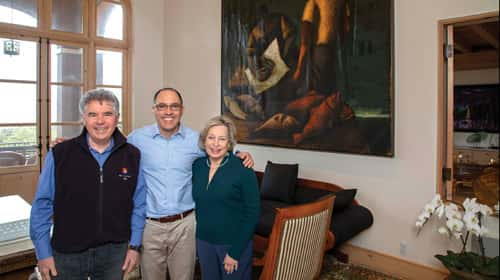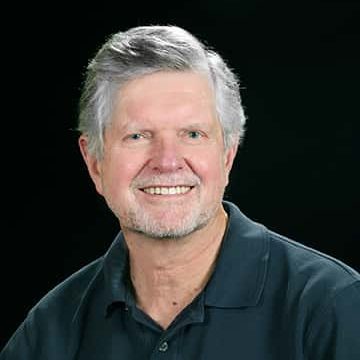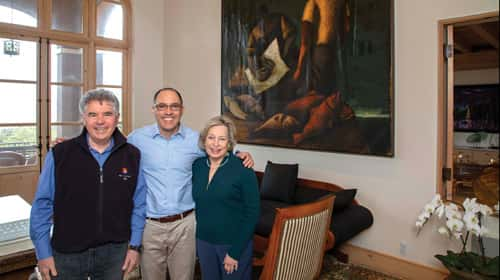Workplace mental health issues cost the global economy a staggering $3 trillion annually. It’s the most significant employee health-related expense, and double that of cardiovascular disease and diabetes combined. Yet this crisis of high cost and human suffering has largely gone unrecognized—though this is changing. What’s not so surprising, California is taking the lead. The private sector and the state government have rallied, and measures are being implemented to address this crisis.
The Staglin family

In the private sector, Napa Valley vintners Shari and Garen Staglin have been involved longer than most. Twenty-nine years ago, their son, Brandon, then age 19, was diagnosed with schizophrenia, a mental disorder that impacts how a person thinks, feels, and acts. Devastated by what happened to him and grateful for his recovery, they resolved to help others. The couple started by organizing a concert at their Staglin Family Vineyard in Rutherford with proceeds going toward mental health research.
For even the most devoted, organizing a fund-raising music festival every year would be enough. But not so for the Staglins, who have grand ambitions of mimicking another acclaimed program, the CEO Roundtable on Cancer. In 2001, President George H.W. Bush established roundtable, made up of chief executives from top corporations in America. Their mandate was to establish a workplace gold standard focusing on prevention, early cancer detection, quality treatment, and elimination of the stigma associated with the “C” word in the workplace. “To a large extent, the roundtable succeeded,” says Garen. “We hope to do the same for mental health.”
One Mind at Work
The Staglins formed a nonprofit, dubbed One Mind, to address a range of mental health issues. Brandon Staglin, in addition to his role as director of marketing communications for the family winery, was appointed president. “My battle with schizophrenia and recognition of what I was dealing with has given me a purpose, and inspired me to help others,” says Brandon. Together with former U.S. Representative Patrick Kennedy, founder of The Kennedy Forum, and with funding provided by Janssen Pharmaceuticals, a unit of Johnson & Johnson, the Staglins started a program they named One Mind at Work.
One Mind at Work’s first initiative centered on the workplace and the development of a standard for addressing mental health. “Mental disorders such as depression, anxiety, bipolar disorder, and attention deficit hyperactivity disorder (ADHD) affect one in four working-age adults,” says Garen. “These issues tend to manifest differently at work than at home and often go unrecognized and untreated due to stigma and discrimination. This results in needless distress and the cost to an employer’s bottom line is significant.” As employees spend 50 percent or more of their waking hours at work, the structure of a workplace is the ideal environment to implement measures and establish a safety net of mental health support.
One Mind at Work gathered data from human resource departments at 13 major employers concerning best practices in mental health promotion and challenges faced. The employers, with an average size workforce of 70,000, represented a range of businesses. Most indicated a reduction of stigma as their priority.
The One Mind at Work program is hands-on and includes all employers, not just corporations. Its members’ top executives must sign a charter committing to best workplace practices that include the elimination of mental health stigma and social prejudice and discrimination, the adoption of proactive preventive measures and early intervention and continuing education. Members have access to a network of experts as well as opportunities to learn and share best practices, and resources for implementation of the Workplace Mental Health Gold Standard. One Mind at Work’s coalition includes Otsuka, Bank of America, UCLA, Levi’s, Walgreens, Cognizant, Cigna, Farmers Insurance, Kaiser, Sutter Health, and ADP among others. Current membership covers 1.5 million employees. “Our goal is to have 10 million employees represented by 2020,” Garen said.
The Staglin’s are indefatigable in their pursuits. One success leads to another idea. One of those ideas brought about the creation of a forum. One Mind at Work will hold its third yearly such event in Napa in September. Global leaders representing research, advocacy and the business community are expected to attend. “We limit participation to a hundred. We want the workshops to be hands on, the discussions lively,” Garen said. “The forums promote open science, are interactive and provide for an exchange of data. It’s amazing all that we’re able to accomplish.”
Says Kathy Farmer, vice president of Global Benefits at Levi Strauss, “I attended the first One Mind at Work forum. The diversity of experience and range of thinking was phenomenal. Rather than trying to solve a difficult workplace mental health problems individually, there was synergy and a constructive exchange of ideas.” Levi’s membership in the One Mind coalition is a natural extension of its own corporate culture and focus on employee wellbeing. In an effort to reduce stigma, Levi invited a respected NFL player to speak about his battle with depression. Most people can’t imagine that those who seem to have everything might suffer from a mental health disorder. Seeing an NFL player address that publicly helped others find their own inner courage. “We recently redesigned our mental health insurance coverage plan,” Farmer said. “It can be difficult for employees to find adequate care through an in-plan network provider. Now we offer out-of-plan coverage as well.” Levi has operations in 45 countries. Each location has an Employee Assistance Program (EAP). Included are 5 free counseling sessions. And there’s special critical counseling related to terrorism and natural disasters. Levi’s corporate wellness programs offer employees mindfulness training, meditation, yoga and coaching.
In partnership with Tufts Medical Center Institute for Clinical Research and Health Policy Studies, One Mind at Work undertook a study focused on workplace mental health, primarily depression, and associated costs. The report, titled “The High Cost of Mental Disorders: Facts for Employers,” confirmed the extraordinary cost and adverse effects on the workplace. Findings did not address the higher and harder-to-define losses in productivity. The study revealed that employees suffering from depression miss anywhere from six to 25 days of work per annum, and suffer impaired performance on the job.
Few employers are cognizant of the high costs due to failed recognition, stigma and underreporting. Yet data shows that there’s a good reason to pay attention. For every dollar invested in mental health programs, there’s a $3 to $5 return on investment. Business leaders are in agreement that not enough is being done; yet they’re unsure where to begin. Getting started, and implementation of standards, is where One Mind at Work can help.
Over the past 25 years, the Staglins have raised more than $390 million for mental health research. “We feel good about what we’ve accomplished,” Garen said. “But in no way are we complacent. There’s so much more to be done.”
Legislation
In 2004, California implemented the Mental Health Services Act (MHSA) and established the Mental Health Oversight and Accountability Commission (MHOAC) to implement the Act’s provision and develop strategies to overcome stigma. That 2004 legislation did not address the workplace, however.
John Boyd, PsyD., was appointed to the Mental Health Services Oversight and Accountability Commission. He began serving as the elected chairman of the commission in 2018. Boyd’s credentials made him the ideal choice. He is chief executive officer of Mental Health Services at Sutter Health. Before joining Sutter Health in 2008, he was assistant administrator for Kaiser Permanente Sacramento Medical Center. He is a board member of National Mental Health America, and has also served in other appointed capacities, including City of Sacramento Planning Commissioner.
The Steinberg Institute, a nonprofit founded by Darrell Steinberg, mayor of Sacramento and former California Senate President pro tempore, partnered with MHSOAC to address workplace mental health in 2018. “Influencing policy making regarding mental health issues is an important part of our mandate,” says Maggie Merritt, executive director at Steinberg.
In September 2018, the California legislature passed SB 1113, which was co-sponsored by MHSOAC and Steinberg Institute. The new legislation’s mandate is: “To establish a framework and voluntary standard for mental health in the workplace that serves to reduce mental health stigma; increase public, employee, and employer awareness of the recovery goals of the Mental Health Services Act; and provide guidance to California’s employer community to put in place strategies and programs as determined by the commission, to support the mental health and wellness of employees.” MHSOAC, with responsibility for developing the standards, will rely on existing best practices developed by corporations and the highly successful model implemented in Canada. Significant work has also been conducted by One Mind at Work, a global coalition of leaders from diverse sectors, including business, medicine, research, education, law enforcement, the military and civil society. These leaders have joined together with the goal of transforming approaches to mental health and addiction. The Steinberg Institute and the MHSOAC have been partners in this effort.
With passage of SB 1113, California became the first state in the nation to institute mental health workplace guidelines. “We are proud to have been part of helping to pass this important, historic legislation,” Merritt said.
In the workplace, employees don’t hesitate to ask their employer for time off to deal with physical ailments, yet refrain from discussing mental health issues, concerned as to how that might be perceived. Employers are now providing gym membership and other similar perks to address employee well-being. SB 1113 is intended to bring that same focus on workplace mental health.
The Canadian approach has taken the lead in addressing mental health in the workplace. In 2013, a Standard for psychological health and safety in the workplace was introduced. Then in 2017, Donna Hardaker made a presentation to California’s legislature on the Canadian model. Hardaker is now manager of Workplace Mental Health and Peer Engagement at Sutter Health.
“Seventeen years ago, I struggled with my own mental health issues. I missed many days of work, had extended sick leave, and disruptive behaviors,” says Hardaker. “My employer didn’t know what to do with me. I had to leave. It was heartbreaking.” Hardaker made a career change and ended up in the then emerging field of workplace mental health at the Canadian Mental Health Association. Her timing was good. It was a magical moment when Canada’s leaders were looking at what to do. “My story became part of the message about transforming workplaces.”
The Standard in Canada is voluntary. “We didn’t want measures to be punitive,” says Hardaker. “We wanted change to come about through a corporate example of fulfilling employee expectations of being in a psychologically healthy and safe work environment.” Setting the example, Canada’s largest employer, the federal government, is implementing the Standard in it offices throughout the country. ‘Psychological health and safety in the workplace’ is a Canadian term that’s commonplace in the country. The thoughts link logically. And in the U.S., that linkage is becoming more apparent.
Health care providers
Boyd first met Hardaker after he heard her speak at an event in San Francisco. “We met afterwards,” Hardaker said. “It became evident we shared a common vision. Sutter’s made a commitment to advances and innovation in the field of mental health. Two years ago, I joined them.”
Hardaker is pioneering a workplace program at Sutter that will be comprehensive and holistic. Rollout is expected later this year. “It’s not often an organization undertakes an internal program and then makes it available to others for free,” Hardaker said.
In addition to Hardaker’s initiative, within the Sutter organization there’s an aptly named ‘Joy to Work’ program where more than 40 clinician leaders focus on improving workplace well-being. This includes the provision of tools and support to address burnout, and bringing joy to the everyday aspects of work. Last year, Sutter hosted its first Well-Being Summit, with 50 practicing clinicians, clinical leaders and executives from across the network assembled to share ideas and best practices. A second summit is scheduled for May this year.
Northern California integrated major health care provider, Kaiser Permanente launched a “Find Your Words” anti-stigma media campaign several years ago, focusing on TV, theater and radio spots. The ads and broadcasts direct viewers to a website with more information about mental health and wellness. The campaign has been successful and is ongoing. “In addition to the media blitz, Kaiser made a $2 million contribution across the Northern California region to support community organizations with their own anti-stigma mental health efforts,” says Dr. John Mackey, M.D., chief of mental health and addiction medicine at Kaiser Permanente. Of those monies, $90,000 went to LifeWorks of Sonoma County, and $90,000 to North Marin Community Services. 
Kaiser’s Employee Assistance Program (EAP) occupies space in a separate facility so employees will feel more comfortable going there for services. The EAP is active and supportive. “During the recent flooding and in the aftermath of the October 2017 fires, our EAP provided assistance to employees affected by those disasters,” MacKey add. Kaiser Permanente also has a physician wellness program, as well as a physician well-being program that focuses on physician wellness, activities, health care and dealing with stress.
Benefits
Arrow Benefits Group, with offices throughout California, including Petaluma and Napa, focuses on de-stigmatizing workplace mental health issues and making its clients aware of specific coverage and available benefits. “To help employees at work, we make corporate culture a part of what we discuss,” says Andrew McNeil, principal and benefits advisor. “This makes us unique among insurance brokers. Most don’t have that level of discussion.” Creating an environment where employees look forward to going to work can affect a business’ bottom line. Estimated costs for replacing an employee range from 10 to 30 percent of annual salary.

“In the wine, construction and manufacturing industries with a high percentage of Latino workers, there’s often cultural stigma surrounding mental health, especially in group workplace settings,” said Rosario Avila, benefits advisor, Alianza Spanish Language Division. HIPAA (Health Insurance Portability and Accountability Act of 1996) provides data privacy and security provisions for safeguarding medical information. “Though HIPPA ensures employee confidentiality, some Spanish-speaking employees worry about filing claims. They’re afraid their employer might find out.” For employees with those concerns, Arrow offers a hotline where Spanish speakers can call with questions.
Currently, 97 percent of U.S. companies with more than 5,000 employees offer employee assistance plans (EAP). For smaller companies that percentage is 75 to 80 percent. EAP’s were started fifty years ago to address alcoholism in the workplace. Now EAP’s cover a range of issues —depression, drug abuse, stress, divorce, career concerns, financial problems, and family care for children and elders. These plans can be offered as part of an employer’s disability coverage, or as a stand-alone benefit through a contractual agreement with a third-party provider. As might be needed, EAP’s can put an employee in contact with experts.
Though available and helpful, the plans are not that widely used. Benefits are often not well-communicated within an organization. And some employees are under the impression that the plans are there to address major medical issues, not day-to-day issues such as wellness, nutrition and work/life balance. And as with filing claims, employees worry about confidentiality. But information can only be released if the employee signs a written statement specifying exactly what can be divulged and to whom. EAP’s are an important tool available to address mental health and well-being. More direction and management awareness might unearth this hidden workplace benefit. Driven by legislation and private sector interests, California is in the vanguard of bringing focus and attention to workplace mental health issues in the US. It’s the hope that over time, stigma will disappear and employees will no longer be wary of seeking, and finding, services.
Music Festival for Brain Health
The Music Festival for Brain Health will celebrate its 25-year anniversary in Napa Valley on September 14. Last year’s event with singer-actress Jennifer Hudson, renowned chefs and local wineries raised more than $5 million. A portion of the monies from the concerts goes to fund Rising Star Awards. That recognition allows emerging scientists with the means to further cutting-edge research on neuropsychiatric disorders, such as anxiety, addiction, bipolar disorder, depression, post-traumatic stress, and schizophrenia. In 2019, up to five recipients will each receive $250,000 to be distributed over three years.
14. Last year’s event with singer-actress Jennifer Hudson, renowned chefs and local wineries raised more than $5 million. A portion of the monies from the concerts goes to fund Rising Star Awards. That recognition allows emerging scientists with the means to further cutting-edge research on neuropsychiatric disorders, such as anxiety, addiction, bipolar disorder, depression, post-traumatic stress, and schizophrenia. In 2019, up to five recipients will each receive $250,000 to be distributed over three years.
For more information, visit www.music-festival.org.
The Cost of Depression
Employers can tally the cost of employee depression to their own organization by using the online cost calculator available on One Mind at Work’s website. It’s interactive and enables employers to input their own relevant data.
For more information, visit onemindatwork.org/at-work/serious-depression-calculator/
Why Focus on Workplace Mental Illness?
1 in 4: Ratio of working-age adults in the U.S. experiencing a mental disorder, regardless of gender, age, race/ethnicity, or occupation.
13%-29%: The percentage of time at work in which depressed employees have impaired performance.
$24 billion: Amount spent annually in the U.S. on lost work productivity due to depression alone.
$1 trillion: Amount the U.S. spends on mental health each year, and increasing.
8.4 million: People in the U.S. who care for a loved one with a mental illness.
Source: One Mind at Work





